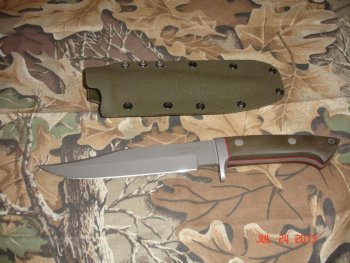Ok gents here's the scenario. I'm a new knife maker. I've got a good friend that is letting me put my knives in his gun store. I stopped in the other day and my friend told me that their was another local maker in the shop ragging on one of my knives because the blade is showing signs of wear from the kydex sheath I made for it (the knife has a bead blasted finish). This guy said I should be able to line it with something. There are a couple of problems I see with lining a kydex sheath with leather or neoprene, ect.....
1) Moisture- Kydex doesn't breath, if I put a liner in a kydex sheath and it gets wet where is the moisture gonna go? You put a carbon steel knife in a wet sock we all know whats gonna happen.
2) Durability- The particular knife he was ragging on is a Bowie inspired fighter. The point on it is very sharp. In an unlined Kydex sheath, you put the blade in crooked and the inside of the sheath is gonna get scratched, no big deal. With a lined sheath, what happens if you put the blade in crooked and the tip catches and tears the lining material? That just seems like a huge headache waiting to happen.
So my question is this. Has anyone who works with kydex regularly ever lined a knife sheath? If so, what did you use and how did you do it? Have you had any problems with the things I listed above?
As an aside, I got pretty ticked off at the guy criticizing my work. We don't know each other and based on his comments, I don't think he's ever worked with kydex before and doesn't understand the material.
P.S. Here is a picture of the knife in question.

1) Moisture- Kydex doesn't breath, if I put a liner in a kydex sheath and it gets wet where is the moisture gonna go? You put a carbon steel knife in a wet sock we all know whats gonna happen.
2) Durability- The particular knife he was ragging on is a Bowie inspired fighter. The point on it is very sharp. In an unlined Kydex sheath, you put the blade in crooked and the inside of the sheath is gonna get scratched, no big deal. With a lined sheath, what happens if you put the blade in crooked and the tip catches and tears the lining material? That just seems like a huge headache waiting to happen.
So my question is this. Has anyone who works with kydex regularly ever lined a knife sheath? If so, what did you use and how did you do it? Have you had any problems with the things I listed above?
As an aside, I got pretty ticked off at the guy criticizing my work. We don't know each other and based on his comments, I don't think he's ever worked with kydex before and doesn't understand the material.
P.S. Here is a picture of the knife in question.

